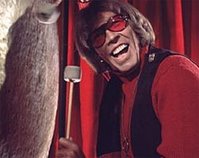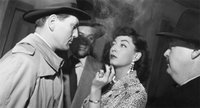The President's Analyst (1967)
 Only two people on earth want Sidney Schaefer alive. Sidney Schaefer. And the President of the United States.
Only two people on earth want Sidney Schaefer alive. Sidney Schaefer. And the President of the United States.James Coburn was one of the coolest guys to be in films, perhaps best remembered for Our Man Flint among others, but one film rarely mentioned features him at his funniest, and is one of the best satires to come out of the 1960s, along with Dr. Strangelove. This long-lost film manages to poke fun at every subject of prevalence imaginable - from the government and its dysfunction (obviously) to suburban family life to hippie culture.
The story involves a certain Dr. Sidney Schaefer (Coburn) who, as one of the top psychoanalysts in the country, is requested to become the official analyst for the President of the United States. Over the course of his sessions with the President, Schaefer learns many dark secrets about the country and its relations with others, and becomes an international liability. As his paranoia grows, he begins to suspect everyone, including his girlfriend. Even his refuge in a hilariously parodied suburban home is tainted with his irrational and ever-escalating fear. As the plot twists and turns, he uncovers a vast conspiracy that threatens the entire world.
The film has its bizarre 1960s moments, such as an acid-induced psychidelic rock concert (wherein Coburn plays the gong!) and the surrealism in much of what it parodies. There are some loose ends that aren't tied up, but the movie is so surrealistic, we half expect a character to wake up, the whole thing having been a nightmare. Director Theodore J. Flicker's expertise lies in television, having directed episodes for shows such as "The Dick Van Dyke Show," "The Andy Griffith Show," and "I Dream of Jeanie," but he uses the cinematic format well. As the writer of this film as well, he shows that he is more than competent in crafting a creative, varied, and hilarious film.
This is a movie with loads of creative ideas, and an unexpected twist every turn. Coburn has never been better, his dry humor carrying much of the picture, but also features a solid supporting cast that makes the brilliant writing as funny as it can be. It is definitely a product of its era, but it parodies basically everything, making it a standout among its peers.


